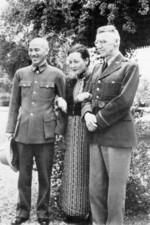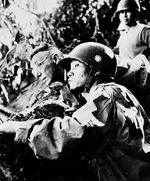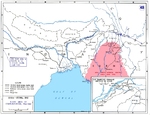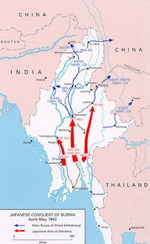
Burma
| Alliance | Allies - Minor Member Nation or Possession | |
| Possessing Power | United Kingdom | |
| Entry into WW2 | 8 Dec 1941 | |
| Population in 1939 | 16,119,000 | |
| Military Deaths in WW2 | 22,000 | |
| Civilian Deaths in WW2 | 250,000 |
Contributor: C. Peter Chen
ww2dbaseAt the end of the First Anglo-Burmese War in 1826, Arakan and Tenasserim regions of coastal Burma were annexed by British India. In 1852, after the Second Anglo-Burmese War, the remainder of Lower Burma was taken by the British. In 1862, British Burma was formed as a chief commissionership of British India. In 1885, after the Third Anglo-Burmese War, Upper Burma was annexed by the British. In 1886, Upper Burma was incorporated into British Burma, which was then elevated to the status of a lieutenant-governorship. Although the Burma in this period of British rule saw tremendous economic growth overall, the growth was arguably detrimental to the better portion of the population of Burma. As Burma was developed into a major rice producer for the British Empire, the influx of Indian workers increased unemployment for the locals, while European land owners slowly expanded their holdings. In terms of treatment of the local peoples, the British systematically uprooted entire villages and transported them to other areas of Burma in an attempt to disrupt the resistance movement. The British did employ some locals, namely the Karen people, which made up of about 25% of the population; the animosity that between the Karen minority and the Burmese majority had already existed prior to the British entry, would be further developed during this time period, and lasting into the modern era.
ww2dbaseIn the 1920s, reforms in British Burma began to give the Burmese people more power in the colonial government, and an university was established to improve the education system. While these reforms somewhat calmed the resistance movement, the very essence of the colonial government itself continued to stir nationalist sentiments. The 1930s saw the development of student groups and political groups dedicated to anti-British causes. In 1937, British Burma was separated from British India, forming a colony of its own; Ba Maw became the first prime minister of the colony. In 1938, Anglo-Burmese tension escalated as strikes and protests which began in the oil fields of central Burma spread across the entire colony, resulting in several deaths as protesters and the police clashed. Ba Maw was succeeded by his political rival U Saw in 1939.
ww2dbaseThe pre-war population of Burma was just over 16 million. 10 million of which were Burmese, 4 million were Karen, and the remaining 2 million were of Shan, Kachin, Naga, Mon, Chin, Chinese, and Indian ethnicities.
ww2dbaseMilitary responsibility for Burma was unorganized in the late 1930s and into the early 1940s. Until 1937, the defense of British Burma fell under the jurisdiction of the British India. Between 1937 and 1940, various British chiefs of staff oversaw its defenses. In 1940, Burma was transferred under the Far Eastern Command based in Singapore. Finally, starting in late 1941 after the outbreak of the Pacific War through early 1942, Burma fell under the command of American-British-Dutch-Australian Command (ABDACOM), which covered a large area that did not allow defense preparation to be carried out effectively. In addition, at least according to the British, not all Burmese administrators working for the colonial government were reliable; in one instance, some Burmese officials approached William Slim to request him not to engage the Japanese in the exclusive Sagaing Hills near Mandalay where many of the elite maintained homes; many of the officials also fled without orders, hampering the British evacuation efforts. The Japanese largely secured Burma by May 1942. The British attempted to attack as early as Sep 1942, and this first campaign was halted by late 1942 and early 1943. While the British continued to train regular troops in India for a potential second assault in the future, Brigadier Orde Wingate launched two long range penetration raids into Burma; while these operations suffered very high casualty rates while destroying little, they provided the Allies in the region the much-needed morale boost. The second Chindit, the name given to Wingate's irregulars, operation overlapped a great Japanese offensive from Burma into eastern India, which was blunted by stubborn defense by British and Indian troops in the Imphal-Kohima region, and made unsustainable as the monsoon season and the jungles made the supplying a large attacking force difficult. The Allies launched another invasion of British Burma in earnest in 1944, and the city of Mandalay was captured by Mar 1945, leading to a nationalist uprising starting on 27 Mar. The capital, Rangoon, was captured in early May.
ww2dbaseFor the majority of the war, the fighting Burma focused on blocking the Japanese from marching northwest into India, and on the restoration of an over-land supply route into southwestern China. This necessarily meant actions in the dense jungles of northern Burma. The English painter and writer Robert Talbot Kelly (1861-1934) visited Burma. He found northern Burma to be beautiful, yet he was not blind to the fact that the pleasant paradise was inhospitable to those who entered unprepared. The weather of Burma had less of a direct threat, but the mid-Mar to mid-Oct monsoon season, which usually brought about 200 inches of rain, nevertheless created trouble for troops fighting on either side.
ww2dbaseFor all foreign troops coming from faraway lands to fight in northern Burma - American, British, Chinese, and Japanese - the most notable animal was the elephant, and they were widely pressed into service pulling heavy equipment and creating trails through heavy vegetation. At the time the war began there were about 20,000 domesticated elephants and about 6,000 in the wild; by the time the war ended, about 18,000 of the 20,000 domesticated elements would be killed as the result of combat, exhaustion, or slipping and falling into deep ravines while carrying heavy military equipment, unable to return to their trails. Another common sight was mules, used to carry equipment. While both Japanese and Allied troops feared predators such as tigers, leopards, and rhinoceros, the animals that caused the most harm were much smaller, coming in the form of snakes. Many would recall snakes sneaking into backpacks, shoes, and even radio equipment, biting when they were threatened by the approaching hands and feet that had no awareless of their presence.
ww2dbase
ww2dbaseThe Japanese occupation presented itself to the Burmese people as liberators. Japan helped organize a Burmese military in mid-1942, and on 1 Aug 1943 formed a nominally independent State of Burma with Ba Maw at its helm. Right from the start, the Japanese had no intention of giving power to the locals. The Burmese military, for example, was intentionally kept at a size that was large enough to appear powerful, but small enough that, if necessary, would be easily wiped aside by the Japanese troops stationed in Southeast Asia. The Japanese pressed Burmese civilians of various ethnicities into construction projects to build roads and railways; ill-treatment, particularly those projects deep in the jungles, suffered very high fatality rates due to disease and malnutrition. A number of massacres also took place in Burma between 1942 and 1945.
ww2dbaseAfter the war, the British colonial administration returned, and it faced stiff resistance from various nationalist groups. In Sep 1946, the police force in Rangoon went on strike to protest against the British, and sympathy strikes soon grew into a general strike all across Burma. Hubert Rance, the British governor since mid-1946, met with Aung San, one of the resistance leaders, and began a process which would ultimately lead to talks of Burmese independence, which was achieved on 4 Jan 1948; before independence was realized, Aung San was assassinated, which was plotted by U Saw. The newly formed Union of Burma chose not join the British Commonwealth due to general anti-British sentiment in the country. In 1962, a coup d'état by the Burmese military overthrew the republic; General Ne Win would maintain dictatorial control over the country for more than 20 years.
ww2dbaseAdditional Note on Burmese Names
ww2dbaseBurmese people do not traditionally make use of a surname.
ww2dbaseTraditionally, Burmese names were one syllable, for example war time collaborationist Nu, but by the WW2-era multiple syllable names were common place, for example, the nationalist revolutionary Aung San.
ww2dbaseBurmese children at times carry on their parents' names as part of their own, but these portions of a name are still not considered a surname. Aung San Suu Kyi is a famous example of this, in which "Aung San" was to honor her father Aung San, "Suu" was to honor her paternal grandmother Suu, and "Kyi" was to honor her mother Khin Kyi; although all referred to family members in full or in part, none of those constituted a family name.
ww2dbaseBurmese people are sometimes referred to using an honorific-name combination, thus Nu was often seen as U Nu, or "Mr. Nu", in literature, while Aung San might at times appear as Bogyoke Aung San, or "Military Officer Aung San".
ww2dbaseSources:
Frank McLynn, The Burma Campaign
Gavin Mortimer, Merrill's Maurauders
Wikipedia
Last Major Update: Mar 2012
| People | ||
| Aung San | Nu | |
| Ba Maw | Seagrave, Gordon | |
| Events Taken Place in Burma | ||
| Burma Road and the Hump | 1 Jan 1938 - 10 Nov 1945 | |
| Invasion of Burma | 14 Dec 1941 - 26 May 1942 | |
| First Battle of Arakan | 21 Dec 1942 - 3 Apr 1943 | |
| Operation Longcloth | 8 Feb 1943 - 27 Apr 1943 | |
| Second Battle of Arakan | 30 Dec 1943 - 6 Apr 1944 | |
| Battle of Myitkyina | 24 Feb 1944 - 3 Aug 1944 | |
| Operation Thursday | 5 Mar 1944 - 27 Aug 1944 | |
| Salween Offensive | 1 Apr 1944 - 27 Jan 1945 | |
| Battle of Bhamo | 14 Nov 1944 - 14 Dec 1944 | |
| Third Battle of Arakan | 12 Dec 1944 - 28 Feb 1945 | |
| Battle of Meiktila-Mandalay | 19 Jan 1945 - 29 Mar 1945 | |
| Battle of Rangoon | 25 Apr 1945 - 6 May 1945 | |
| Facilities | ||
| Lashio Airfield | Air Base | |
Photographs
 |  |
 |  |
Burma in World War II Interactive Map
Please consider supporting us on Patreon. Even $1 per month will go a long way! Thank you. Please help us spread the word: Stay updated with WW2DB: |
Visitor Submitted Comments
23 Mar 2019 07:43:52 PM
My grandfather was part of World War 2. I want to inquire about his memorial. I am giving you some information about him .I think it will be useful for you to get my grand fathers details.
Lance Havaldar Joginder Singh Regiment Number -54102
1st Burma Regiment
Date of Death -FEB 16 ,1945
> Casualty War: Second World War
>
> Casualty Surname: Singh / Mrahard
>
> Casualty Forenames: JOGINDER
>
7 Jun 2019 03:18:18 AM
Looking to find info on my grandad Leonard george Bushell pls
20 Jul 2019 01:41:41 AM
Looking for Vernon D'Sylva
30 Aug 2019 10:16:30 PM
My father Alexander John Wilson served in Burma with wingate. I believe his ran was Major and his Reg number 9047?
Dad died in 1966 and I have precious little information about him
Any help you can give would be most welcom
5 Dec 2019 02:36:59 AM
Looking for details about my grandfather who lived in Dedaya . His surname ..undru / Vundru .Name: Gangaiah / Gangayya.
24 Mar 2020 03:07:37 PM
Hi I am looking for my great grandfather Syed Ahmed or Ahmad Shah who died in Burma during world war 2. He was from Pakistan
Would appreciate your response
Thanks
All visitor submitted comments are opinions of those making the submissions and do not reflect views of WW2DB.

- » Wreck of Teruzuki Found (27 Jul 2025)
- » USS Orlean's Bow Found (22 Jul 2025)
- » The Emperor of Japan Planned to Honor WW2-era Japanese POWs in Mongolia (4 Jul 2025)
- » US State Lawmaker John Winter Caught Using Racial Slur "Jap" and Apologized (11 Jun 2025)
- » US Government Plans to Purge WW2 Information (17 Mar 2025)
- » See all news
- » 1,182 biographies
- » 337 events
- » 45,119 timeline entries
- » 1,248 ships
- » 350 aircraft models
- » 207 vehicle models
- » 376 weapon models
- » 123 historical documents
- » 261 facilities
- » 470 book reviews
- » 28,411 photos
- » 365 maps
Lt. Gen. Lewis B. "Chesty" Puller, at Guadalcanal
7 Oct 2018 01:51:04 AM
Looking for an uncle who was killed in Burma in 1943 body never found he was Sargent Ronald Arthur Hawkins he had full wings on his uniform so I presume he was a pilot
Hope you can help Thanks